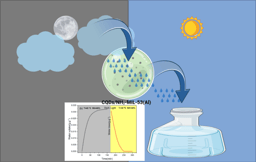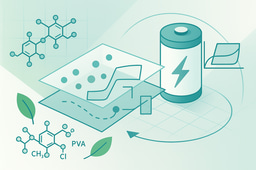Unlocking High Energy Density and Stable Electric Double Layer Capacitor Derived from Sustainable Biodegradable Polymer Electrolyte Based on Chitosan:Polyvinyl Alcohol: Potassium Thiocyanate:xGlycerol (10≤x≤30)
Published in Materials

Explore the Research
Failed
Failed to retrieve the data.
Electrochemical double-layer capacitors (EDLCs) deliver rapid charge–discharge and long lifetimes, but boosting energy density without sacrificing safety is still the big challenge. Our new study engineers a biopolymer blend electrolyte—chitosan:poly(vinyl alcohol):KSCN plasticized with glycerol (x = 10–30 wt%)—that couples strong molecular interactions with improved ion transport to unlock ion-dominant conduction, a wide stability window, and robust EDLC performance.
Highlights of our study
-
Green, plasticized electrolyte architecture. A CS–PVA host doped with KSCN and plasticized by glycerol shows clear hydrogen-bonding/complexation signatures (e.g., SCN– band shift near ~2037→~2053 cm⁻¹) and reduced ion-migration resistance—foundational for higher K⁺ mobility.
-
Dielectric advantage that favors storage. Across frequency, ε′ > ε″, and tan δ peaks shift to higher frequencies with more glycerol—fingerprints of enhanced segmental dynamics and faster ion transport.
-
Electrochemical metrics that matter. t₍ion₎ = 0.952 (ion-dominant conduction) and an electrochemical stability window up to 2.85 V support wide-window EDLC operation.
-
Device-level performance confirmed. Nearly rectangular CVs and triangular GCDs (non-Faradaic storage) yield ~80 F g⁻¹ specific capacitance with ~11.26 Wh kg⁻¹ energy and ~3176 W kg⁻¹ power; ESR is low (≈30–40 Ω).
-
Cycle stability. The cell sustains efficient cycling with stable capacitance and low internal resistance over extended testing, consistent with the electrolyte’s ion-led transport and wide safe window.
Why it matters
Biopolymer electrolytes advance safety, sustainability, and manufacturability. By tuning the dielectric environment and segmental mobility via a green plasticizer, this work points to a practical route for narrowing the energy gap to batteries while preserving supercapacitor-class power—relevant for wearables, EV auxiliary systems, and grid services.
Paper details
Title: Unlocking High Energy Density and Stable EDLC Derived from Sustainable Biodegradable Polymer Electrolyte Based on Chitosan:Polyvinyl Alcohol: Potassium Thiocyanate:xGlycerol (10 ≤ x ≤ 30)
Journal: Results in Engineering (Accepted: 21 Aug 2025) — DOI: 10.1016/j.rineng.2025.106897.
Authors & Affiliations:
Shujahadeen B. Aziz*, Dara M. Aziz, Peshawa O. Hama, Rebar T. Abdulwahid, Niyaz M. Sadiq, Sameerah I. Al-Saeedi, Mohd F. Z. Kadir, Sambasivam Sangaraju*, Jacky Yong, H. J. Woo — University of Sulaimani; University of Raparin; Sulaimani Polytechnic University; Princess Nourah bint Abdulrahman University; Universiti Malaya (and UMCiL); United Arab Emirates University. (Corresponding: shujahadeenaziz@gmail.com



Please sign in or register for FREE
If you are a registered user on Research Communities by Springer Nature, please sign in